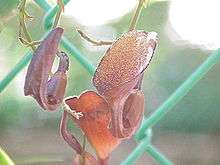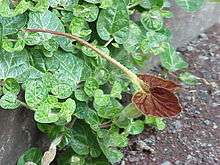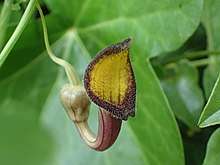Aristolochia
Aristolochia (English: /əˌrɪstəˈloʊkiə/) is a large plant genus with over 500 species that is the type genus of the family Aristolochiaceae. Its members are commonly known as birthwort, pipevine or Dutchman's pipe and are widespread and occur in the most diverse climates. Some species, like A. utriformis and A. westlandii, are threatened with extinction.
| Aristolochia | |
|---|---|
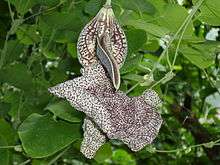 | |
| Aristolochia labiata | |
| Scientific classification | |
| Kingdom: | Plantae |
| Clade: | Tracheophytes |
| Clade: | Angiosperms |
| Clade: | Magnoliids |
| Order: | Piperales |
| Family: | Aristolochiaceae |
| Subfamily: | Aristolochioideae |
| Genus: | Aristolochia L.[1] |
| Species | |
|
Over 500, see text | |
| Synonyms | |
|
Hocquartia Dum.
| |
Isotrema is usually included here, but might be a valid genus. If so, it contains those species with a three-lobed calyx.
Description
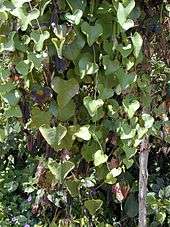
Aristolochia is a genus of evergreen and deciduous lianas (woody vines) and herbaceous perennials. The smooth stem is erect or somewhat twining. The simple leaves are alternate and cordate, membranous, growing on leaf stalks. There are no stipules.
The flowers grow in the leaf axils. They are inflated and globose at the base, continuing as a long perianth tube, ending in a tongue-shaped, brightly colored lobe. There is no corolla. The calyx is one to three whorled, and three to six toothed. The sepals are united (gamosepalous). There are six to 40 stamens in one whorl. They are united with the style, forming a gynostemium. The ovary is inferior and is four to six locular.
These flowers have a specialized pollination mechanism. The plants are aromatic and their strong scent[2] attracts insects. The inner part of the perianth tube is covered with hairs, acting as a fly-trap. These hairs then wither to release the fly, covered with pollen.
The fruit is dehiscent capsule with many endospermic seeds.
The common names Dutchman's pipe and pipevine (e.g. common pipevine, A. durior) are an allusion to old-fashioned meerschaum pipes at one time common in the Netherlands and northern Germany. Birthwort (e.g. European birthwort A. clematitis) refers to these species' flower shape, resembling a birth canal. Aristolochia was first described by the 4th c. BC Greek philosopher and botanist Theophrastos in his book [Inquiry of Plants, IX.8.3], and the scientific name Aristolochia was developed from Ancient Greek aristos (άριστος) "best" + locheia (λοχεία), childbirth or childbed, relating to its known ancient use in childbirth.[3][4] The Roman orator Cicero records a different tradition, that the plant was named for the otherwise unknown individual with the common Greek name Aristolochos, who had learned from a dream that it was an antidote for snake bites.[5]

Herbalism, toxicity and carcinogenicity
The species Aristolochia clematitis was highly regarded as a medicinal plant since the ancient Egyptians, Greeks and Romans, and on until the Early Modern era; it also plays a role in traditional Chinese medicine. Due to its resemblance to the uterus, the doctrine of signatures held that birthwort was useful in childbirth. A preparation was given to women upon delivery to expel the placenta, as noted by the herbalist Dioscurides in the 1st century AD. Despite its presence in ancient medicine, Aristolochia is known to contain the lethal toxin aristolochic acid.
The Bencao Gangmu, compiled by Li Shi-Zhen in the latter part of the sixteenth century, was based on the author's experience and on data obtained from earlier herbals; this Chinese herbal classic describes 1892 "drugs" (with 1110 drawings), including many species of Aristolochia.[6] For 400 years, the Bencao Gangmu remained the principal source of information in traditional Chinese medicine and the work was translated into numerous languages, reflecting its influence in countries other than China. In the mid-twentieth century, the Bencao Gangmu was replaced by modern Materia Medica, the most comprehensive source being Zhong Hua Ben Cao (Encyclopedia of Chinese Materia Medica), published in 1999.[7] The Encyclopedia lists 23 species of Aristolochia, though with little mention of toxicity. The Chinese government currently lists the following Aristolochia herbs: A. manshuriensis (stems), A. fangchi (root), A. debilis (root and fruit), and A. contorta (fruit), two of which (madouling and qingmuxiang) appear in the 2005 Pharmacopoeia of the People's Republic of China.
In traditional Chinese medicine Aristolochia species are used for certain forms of acute arthritis and edema.[8][9][10]
Despite the toxic properties of aristolochic acid, naturopaths claim that a decoction of birthwort stimulates the production and increases the activity of white blood cells,[11] or that pipevines contain a disinfectant which assists in wound healing.[12] Also, Aristolochia bracteolata is colloquially known as "worm killer" due to supposed antihelminthic activity.[13]
Aristolochia taxa have also been used as reptile repellents. A. serpentaria (Virginia snakeroot) is thus named because the root was used to treat snakebite, as "so offensive to these reptiles, that they not only avoid the places where it grows, but even flee from the traveler who carries a piece of it in his hand".[14] A. pfeiferi,[15] A. rugosa,[16] and A. trilobata[17] are also used in folk medicine to treat snakebites.

Toxicity and carcinogenicity
In 1993, a series of end-stage renal disease cases was reported[9][18] from Belgium associated with a weight loss treatment, where Stephania tetrandra in a herbal preparation was suspected of being substituted with Aristolochia fangchi.[19][20] More than 105 patients were identified with nephropathy following the ingestion of this preparation from the same clinic from 1990 to 1992. Many required renal transplantation or dialysis.[21] Aristolochia is a component of some Chinese herbal medicines.[22]
Aristolochia has been shown to be both a potent carcinogen and kidney toxin. Herbal compounds containing Aristolochia are classified as a Group 1 carcinogen by the International Agency for Research on Cancer.[23] Epidemiological and laboratory studies have identified Aristolochia to be a dangerous kidney toxin; Aristolochia has been shown associated with more than 100 cases of kidney failure.[24] Furthermore, it appears as if contamination of grain with European birthwort (A. clematitis) is a cause of Balkan nephropathy, a severe renal disease occurring in parts of southeast Europe.[25] In 2001 the UK government banned the sale, supply and importation of any medicinal product consisting of or containing a plant of the genus Aristolochia.[26] Several other plant species that do not cause themselves kidney poisoning, but which were commonly substituted with Aristolochia in the remedies, were prohibited in the same order.[27]
Aristolochic acid was linked to aristolochic acid-associated urothelial cancer in a Taiwanese study in 2012.[28] In 2013, two studies reported that aristolochic acid is a strong carcinogen. Whole-genome and exome analysis of individuals with a known exposure to aristolochic acid revealed a higher rate of somatic mutation in DNA.[29][30] Metabolites of aristolochic acid enter the cell nucleus and form adducts on DNA. While adducts on the transcribed DNA strand within genes are detected and removed by transcription-coupled repair, the adducts on the non-transcribed strand remain and eventually cause DNA replication errors. These adducts have a preference for adenine bases, and cause A-to-T transversions. Furthermore, these metabolites appear to show a preference for CAG and TAG sequences.
Garden history
Due to their spectacular flowers, several species are used as ornamental plants, notably the hardy A. durior of eastern North America, which was one of John Bartram's many introductions to British gardens; in 1761 Bartram sent seeds he had collected in the Ohio River Valley to Peter Collinson in London, and Collinson gave them to the nurseryman James Gordon at Mile End to raise. The vine was soon adopted for creating for arbors "a canopy impenetrable to the rays of the sun, or moderate rain," as Dr John Sims noted in The Botanical Magazine, 1801.[31]
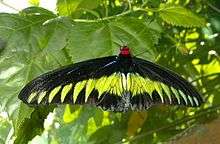
Swallowtail butterflies
Many species of Aristolochia are eaten by the caterpillar larvae of swallowtail butterflies, thus making themselves unpalatable to most predators. Lepidoptera feeding on pipevines include:
- False Apollo (Archon apollinus) – known from numerous pipevine species
- Bhutanitis
- Troidini
- Great windmill (Atrophaneura dasarada) – only known from A. griffithi
- Common batwing (Atrophaneura varuna) – only known from A. kaempferi
- Troides plateni – only known from Indian birthwort (A. tagala)
- Cairns birdwing (Ornithoptera euphorion)
- Richmond birdwing (O. richmondia)
- Paradise birdwing (O. paradisea)
- Rajah Brooke's birdwing (Trogonoptera brookiana) – only known from A. foveolata
- Magellan birdwing (T. magellanus) – known on A. cucurbitifolia, A. ovatifolia, A. zollingeriana and maybe others
- Pipevine swallowtail (Battus philenor) – known on A. macrophylla, Virginia snakeroot (A. serpentaria) and others
In Australia the invasive Aristolochia littoralis is fatal to the caterpillars of Ornithoptera euphorion and O. richmondia and threatens to displace their proper host, A. tagala.
Selected species
- Aristolochia acuminata Lam.
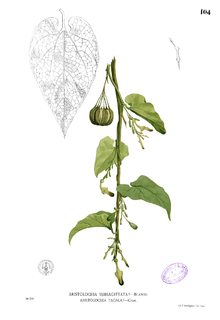 Aristolochia acuminata habitus drawing
Aristolochia acuminata habitus drawing - Aristolochia acutifolia
- Aristolochia allemanii
- Aristolochia anguicida Jacq. – harlequin Dutchman's pipe
- Aristolochia arborea
 Aristolochia arborea flowers
Aristolochia arborea flowers - Aristolochia arcuata Mast.
- Aristolochia auricularia
- Aristolochia baetica
- Aristolochia bilabiata L. – West Indian Dutchman's pipe
- Aristolochia billardieri
- Aristolochia bilobata – two-lobed Dutchman's pipe
- Aristolochia bodamae
- Aristolochia boosii
- Aristolochia bottae
- Aristolochia bracteolata Lam. – worm killer
- Aristolochia bridgesii – Chilean yellow fox's ears
- Aristolochia burelae
- Aristolochia californica Torr. – California pipevine, California Dutchman's pipe
- Aristolochia cauliflora Ule
- Aristolochia caudata
- Aristolochia chachapoyensis
- Aristolochia chapmaniana (= A. tonduzii)
- Aristolochia chilensis Bridges ex Lindl. – Chilean fox's ears
- Aristolochia chrismulleriana[34]
- Aristolochia clematitis L. – European birthwort
- Aristolochia colossifolia – giant-leaved aristolochia
- Aristolochia constricta
- Aristolochia contorta
- Aristolochia cordiflora
- Aristolochia cordigera
- Aristolochia cornuta
- Aristolochia coryi I.M.Johnst – Cory's Dutchman's pipe
- Aristolochia cucurbitifolia Hayata
- Aristolochia cucurbitoides C.F.Liang
- Aristolochia cymbifera Mart.
- Aristolochia daemoninoxia

- Aristolochia dalyi
- Aristolochia delavayi Franch.
- Aristolochia deltantha
- Aristolochia deltoidea
- Aristolochia didyma – yawar panga
- Aristolochia durior (= A. macrophylla) – common Dutchman's pipe, common pipevine
- Aristolochia erecta – swanflower
- Aristolochia eriantha
- Aristolochia esperanzae Kuntze
- Aristolochia fangchi Y.C.Wu ex L.D.Chow & S.M.Hwang
- Aristolochia filipendulina
- Aristolochia fimbriata – white-veined Dutchman's pipe
- Aristolochia foetida – Jalisco Dutchman's pipe
- Aristolochia foveolata
- Aristolochia galeata
- Aristolochia gibertii
- Aristolochia gigantea Mart. – giant pelican flower, Brazilian Dutchman's pipe
- Aristolochia glandulosa J.Kickx f. – Cuban birthwort
- Aristolochia gorgona
- Aristolochia grandiflora Sw. – pelican flower
- Aristolochia griffithi
- Aristolochia guentheri
- Aristolochia hainanensis Merr.
- Aristolochia hians
- Aristolochia hirta
- Aristolochia holtzei
- Aristolochia indica L.
- Aristolochia inflata
- Aristolochia iquitensis
- Aristolochia islandica
- Aristolochia kaempferi Willd.
- Aristolochia kewensis
- Aristolochia klugii – moth-winged birthwort
- Aristolochia labiata Willd. – mottled Dutchman's pipe, rooster flower
- Aristolochia leuconeura
- Aristolochia lindneri
- Aristolochia lingulata
- Aristolochia littoralis D.Parodi – elegant Dutchman's pipe, calico flower
- Aristolochia longa – long aristolochia, sarrasine
- Aristolochia macrophylla Lam.
- Aristolochia macroura
- Aristolochia manchuriensis
- Aristolochia mathewsii
- Aristolochia maurorum
- Aristolochia maxima Jacq. – Florida Dutchman's pipe
- Aristolochia moupinensis
- Aristolochia nana – tiny pelican flower
- Aristolochia obliqua S.M.Hwang
- Aristolochia odoratissima L. – fragrant Dutchman's pipe
- Aristolochia orbicularis
- Aristolochia ornithocephala – bird's head pipevine
- Aristolochia ovalifolia
- Aristolochia paecilantha
- Aristolochia pallida
- Aristolochia parviflora
- Aristolochia paulistana Hoehne
- Aristolochia peltata L. – peltate Dutchman's pipe
- Aristolochia pentandra Jacq. – Marsh's Dutchman's pipe
- Aristolochia pfeiferi – dubsangid (Kuna language)
- Aristolochia pilosa
- Aristolochia pistolochia L.
- Aristolochia poecilantha
- Aristolochia pontica
- Aristolochia prostrata
- Aristolochia pubera
- Aristolochia quangbinhensis
- Aristolochia raja
- Aristolochia reticulata Jacq. – Red River snakeroot, Texas Dutchman's pipe
- Aristolochia ridicula N.E.Br.
- Aristolochia ringens Vahl – gaping Dutchman's pipe
- Aristolochia rotunda L. – smearwort, round birthwort, English mercury, mercury goosefoot, allgood, tola bona, fat hen – type species
- Aristolochia rugosa Lam. – mat root (Trinidad and Tobago)
- Aristolochia salvadorensis
- Aristolochia salvadorensis platensis
- Aristolochia schippii
- Aristolochia scytophylla S.M.Hwang & D.L.Chen
- Aristolochia sempervirens L.
- Aristolochia serpentaria L. – Virginia snakeroot
- Aristolochia silvatica
- Aristolochia sipho L'Hér.
- Aristolochia socorroensis
- Aristolochia sprucei – spruce-leaved aristolochia
- Aristolochia stevensii Barringer
- Aristolochia stomachoides
- Aristolochia surinamensis Willd.
- Aristolochia tagala – Indian birthwort
- Aristolochia taliscana
- Aristolochia tentaculata
- Aristolochia thozetii
- Aristolochia thwaitesii Hook
- Aristolochia tomentosa Sims – woolly pipevine, woolly Dutchman's pipe
- Aristolochia tricaudata
- Aristolochia trilobata – bejuco de Santiago (Trinidad and Tobago)
- Aristolochia tuberosa C.F.Liang & S.M.Hwang
- Aristolochia urupaensis – heart-leaved aristolochia
- Aristolochia utriformis S.M.Hwang
- Aristolochia watsonii Woot. & Standl. – Watson's Dutchman's pipe
- Aristolochia weddellii
- Aristolochia westlandii Hemsl.
- Aristolochia wrightii Seem.
- Aristolochia yunnanensis Franch.[35][36]
Formerly placed here
- Abuta amara (as Aristolochia amara)
- Pararistolochia goldieana (Hook.f.) Hutch. & Dalziel (as A. goldieana Hook.f.)[35]
See also
- Nepenthes aristolochioides, a carnivorous plant with pitchers resembling Aristolochia flowers
- Opodeldoc
Footnotes
- "Genus: Aristolochia L." Germplasm Resources Information Network. United States Department of Agriculture. 2009-01-30. Retrieved 2011-01-08.
- "sometimes with a very disagreeable odour" remarks the Royal Horticultural Society, Dictionary of Gardening.
- "Jepson Manual: Aristolochia". Ucjeps.berkeley.edu. Retrieved 2013-08-15.
- "Missouri Botanical Garden". Mobot.org. Retrieved 2013-08-15.
- Cicero, On Divination 1.10.16
- Grollman, A. P., et al. (2009) Aristolochic acid nephropathy: An environmental and iatrogenic disease. In: Fishbein, J. C. (ed.) Advances in Molecular Toxicology Vol. 3. Amsterdam: Elsevier. pp 211-22.
- Health Department and National Chinese Medicine Management Office (ed.). Zhong Hua Ben Cao, 3–460–509. Shanghai Science Technology Publication. 1999.
- Bensky, D., et al. Chinese Herbal Medicine: Materia Medica, Third Edition. 2004. pp 1054-55.
- Vanherweghem, J.-L.; Tielemans, C.; Abramowicz, D.; Depierreux, M.; Vanhaelen-Fastre, R.; Vanhaelen, M.; Dratwa, M.; Richard, C.; Vandervelde, D.; Verbeelen, D.; Jadoul, M. (February 1993). "Rapidly progressive interstitial renal fibrosis in young women: association with slimming regimen including Chinese herbs". Lancet. 341 (8842): 387–91. doi:10.1016/0140-6736(93)92984-2. ISSN 0140-6736. PMID 8094166.
- Vanhaelen, Maurice; Vanhaelen-Fastre, Renée; But, Paul; Vanherweghem, Jean-Louis (January 1994). "Identification of aristolochic acid in Chinese herbs". Lancet. 343 (8890): 174. doi:10.1016/S0140-6736(94)90964-4. ISSN 0140-6736. PMID 7904018.
- Chevallier, Andrew (2016). Encyclopedia of Herbal Medicine. Penguin. p. 171. ISBN 9781465456755.
- Wood, Michael (March 2004). "Dutchman's Pipe (Aristolochia californica)". Yerbabuena org.
- D Udhaya Nandhini, M Rajasekar, T Venmathi (February 2017). "A review on worm killer: Aristolochia bracteolata" (PDF). Journal of Pharmacognosy and Phytochemistry.CS1 maint: multiple names: authors list (link)
- Freeman-Mitford, A. B. The Bamboo Garden (1896) quoted in Alice M. Coats, Garden Shrubs and Their Histories (1964) 1992, s.v. "Aristolochia".
- Jorge Ventocilla, Heraclio Herrera, Valerio Núñez (2010). Plants and Animals in the Life of the Kuna. University of Texas Press. ISBN 9780292786790.CS1 maint: multiple names: authors list (link)
- Uphof, J. C. Th. (1959). Dictionary of Economic Plants. la Universidad de Michigan.
- Giovannini, P; Howes, M. R (March 2017). "Medicinal plants used to treat snakebite in Central America: Review and assessment of scientific evidence". Journal of Ethnopharmacology. 199: 240–256. doi:10.1016/j.jep.2017.02.011. PMID 28179114.
- Depierreux et al. (1994)
- The names han fang ji (漢防己, Chinese fang ji - S. tetrandra) and guan fang ji (廣防己, Broad fang ji - A. fanchi) had apparently been confused.
- Stiborova et al. (1999)
- Vergano, D. Herbal 'remedy' may trigger widespread kidney failure. USA Today April 16, 2012.
- Li, X; Yang, L; Yu, Y (2001). "An analysis of the clinical and pathological characteristics of Mu-tong (a Chinese herb) induced tubulointerstitial nephropathy". Zhonghua Nei Ke Za Zhi. 40: 681–7.
- ACS (2006)
- Cosyns, J. P. (2003). "Aristolochic acid and 'Chinese herbs nephropathy': a review of the evidence to date". Drug Saf. 26 (1): 33–48. doi:10.2165/00002018-200326010-00004. PMID 12495362.
- Grollman et al. (2007)
- Statutory Instruments 2001 No. 1841. The Medicines (Aristolochia and Mu Tong etc.) (Prohibition) Order 2001. http://www.legislation.gov.uk/uksi/2001/1841/made
- Illegal herbal remedies containing Aristolochia: vigilance needed. MHRA continues to identify cases of herbal medicines, particularly traditional Chinese medicines, which contain illegal and toxic Aristolochia or aristolochic acids. 11 December 2014. Medicines and Healthcare products Regulatory Agency. https://www.gov.uk/drug-safety-update/illegal-herbal-remedies-containing-aristolochia-vigilance-needed
- Chen, C.; et al. (2012). "Aristolochic acid-associated urothelial cancer in Taiwan". Proceedings of the National Academy of Sciences. 109 (21): 8241–46. doi:10.1073/pnas.1119920109. PMC 3361449. PMID 22493262.
- S. L. Poon, S.-T. Pang, J. R. McPherson, W. Yu, K. K. Huang, P. Guan, W.-H. Weng, E. Y. Siew, Y. Liu, H. L. Heng, S. C. Chong, A. Gan, S. T. Tay, W. K. Lim, I. Cutcutache, D. Huang, L. D. Ler, M.-L. Nairismägi, M. H. Lee, Y.-H. Chang, K.-J. Yu, W. Chan-on, B.-K. Li, Y.-F. Yuan, C.-N. Qian, K.-F. Ng, C.-F. Wu, C.-L. Hsu, R. M. Bunte, M. R. Stratton, P. A. Futreal, W.-K. Sung, C.-K. Chuang, C. K. Ong, S. G. Rozen, P. Tan, B. T. Teh, Genome-Wide Mutational Signatures of Aristolochic Acid and Its Application as a Screening Tool.Sci. Transl. Med. 5, 197ra101 (2013)
- M. L. Hoang, C.-H. Chen, V. S. Sidorenko, J. He, K. G. Dickman, B. H. Yun, M. Moriya, N. Niknafs, C. Douville, R. Karchin, R. J. Turesky, Y.-S. Pu, B. Vogelstein, N. Papadopoulos, A. P. Grollman, K. W. Kinzler, T. A. Rosenquist, Mutational Signature of Aristolochic Acid Exposure as Revealed by Whole-Exome Sequencing. Sci. Transl. Med. 5, 197ra102 (2013)
- Quoted in Coats (1964) 1992.
- "Bhutan Glory Butterfly". Knowledge Base.
- "Bhutan Glory (Bhutanitis lidderdalii)". Astronomy to Zoology. 2015.
- Takeuchi, W (2013). "Floristic records from the upper Sepik of Papua New Guinea: Aristolochia chrismülleriana sp. nov. (Aristolochiaceae), Monanthocitrus paludosa (Rutaceae), and Secamone timorensis (Apocynaceae)" (PDF). Phytotaxa. 114 (1): 51–57. doi:10.11646/phytotaxa.114.1.5.
- "GRIN Species Records of Aristolochia". Germplasm Resources Information Network. United States Department of Agriculture. Retrieved 2011-01-08.
- "Aristolochia". Integrated Taxonomic Information System. Retrieved 2011-01-08.
References
- American Cancer Society (ACS (2006): Known and Probable Carcinogens (Including Industrial Processes, Occupational Exposures, Infectious Agents, Chemicals, and Radiation). Version of 02/03/2006. Retrieved 2007-NOV-12.
- Depierreux, M.; et al. (August 1994). "Pathologic aspects of a newly described nephropathy related to the prolonged use of Chinese herbs". American Journal of Kidney Diseases. 24 (2): 172–180. doi:10.1016/s0272-6386(12)80178-8. PMID 8048421.
- Grollman, A. P.; et al. (2007). "Aristolochic acid and the etiology of endemic (Balkan) nephropathy". PNAS. 104 (20): 12129–12134. doi:10.1073/pnas.0701248104. PMC 1913550. PMID 17620607. Supporting information
- Heinrich, M.; et al. (2009). "Local uses of Aristolochia species and content of aristolochic acid 1 and 2 – a global assessment based on bibliographic sources". Journal of Ethnopharmacology. 125 (1): 108–44. doi:10.1016/j.jep.2009.05.028. PMID 19505558.
- Stiborova, M.; et al. (July 1999). "Aristolactam I a metabolite of aristolochic acid I upon activation forms an adduct found in DNA of patients with Chinese herbs nephropathy". Experimental Toxicological Pathology. 51 (4–5): 421–427. doi:10.1016/s0940-2993(99)80033-5. PMID 10445409.
Further reading
- Mathew, J. E.; et al. (2011). "Anti-inflammatory, antipruritic and mast cell stabilizing activity of Aristolochia indica" (PDF). Iranian Journal of Basic Medical Sciences. 14 (5): 422–27. PMC 3586839. PMID 23493617. Archived from the original (PDF) on 2015-06-10. Retrieved 2012-08-17.
- Sati, H.; et al. (2011). "Phytochemical and pharmacological potential of Aristolochia indica: A review" (PDF). Research Journal of Pharmaceutical, Biological and Chemical Sciences. 2 (4): 647–54.
External links
| Look up aristolochia in Wiktionary, the free dictionary. |
| Wikimedia Commons has media related to Aristolochia. |
| Wikispecies has information related to Aristolochia |
- Pictures of Aristolochia chilensis and Aristolochia bridgesii
_(2).jpg)
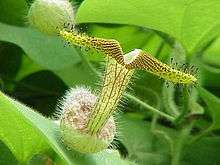

_(14522217697).jpg)
